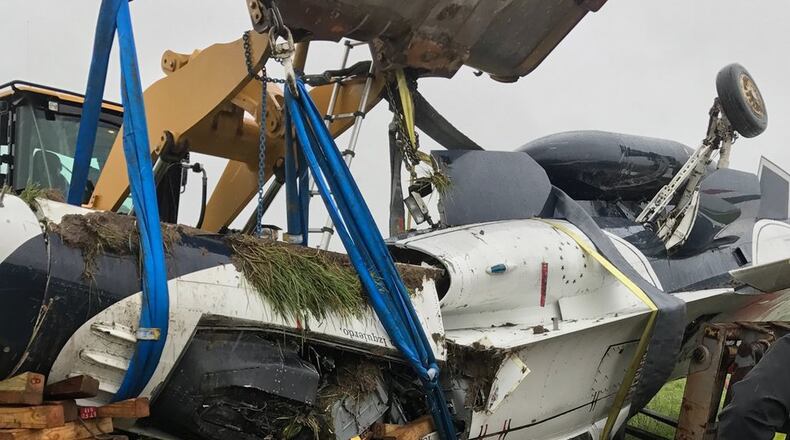In an exclusive interview with this news organization, Gonsalves recounted the June 23, 2017, crash, which occurred as he prepared for last year's Vectren Dayton Air Show at the Dayton International Airport. It was Gonsalves's first media interview about the crash and the first time the full extent of his injuries has been made public.
Gonsalves suffered two broken ribs, a fractured leg and ankle, and a torn patella tendon in his knee from the crash. While in the hospital, his diaphragm punctured, filling his chest cavity with blood. All told, he underwent three surgeries and spent a week in the hospital.
Tech Sergeant Kenneth Cordova, who was riding in the back of the two-seater fighter jet, was taken to Miami Valley Hospital to be evaluated as a precaution but was released later that day. “I just remember telling (Cordova), ‘Hey, man the crash rescue guys will be here soon. Let’s just sit tight,” Gonsalves said.
The United States Air Force Thunderbirds are among the most elite pilots in the world, but the crash last June — and the deadly crash at the Nevada Test and Training Range at Creech Air Force Base last month — serves as a reminder of how dangerous those jobs can be.
Maj. Stephen Del Bagno, Thunderbird No. 4 and the team’s slot pilot, was killed April 4 when his F-16 Fighting Falcon crashed during a practice for the team’s performance at an air show in Southern California. The squadron stopped flying for two weeks and canceled multiple air show appearances after the crash.
The Air Force is currently investigating the deadly mishap, but has not yet released a cause. It was the first deadly crash for the Thunderbirds since four pilots were killed in a crash at the Nevada Test and Training Range in 1982.
Del Bagno’s death also marks the first time the team has been grounded since Gonsalves’ plane flipped over last summer.
An Air Force investigation found excessive air speed coupled with landing too far down a wet runway caused the crash in Dayton.
Gonsalves said driving rain and gusty winds forced him to abort his first landing attempt.
“We were thinking about going down toward the Cincinnati-area where the weather was a little better,” he said. “I was getting ready to divert down south when (air traffic control) said, ‘Hey, it’s clearing up here.’ So I was like, ‘OK, well if that’s the case then I’ll come back in for one more approach.”
The rain and wind picked up again during the landing, however, causing Gonsalves to land further down the runway than he was hoping.
“I got a little fast on final air and just landed a little bit long and then started hydroplaning and couldn’t get the airplane stopped,” he said. “I realized I didn’t have enough runway left to go around and I didn’t think I was going to be able to stop the jet. So I shut the engine off hoping that we would just kind of go into the grass, the airplane would settle, we would tow it back in, inspect it for damage and then be OK. But then ultimately, obviously it flipped which we weren’t anticipating.”
Senior Master Sgt. Trip Bolding, the team’s maintenance superintendent, had just arrived at the airport for his shift with the team. “I watched (Gonsalves) touch down and I just heard a noise and I turned back and looked and that’s when I saw that the aircraft was upside down in the grass,” Bolding said in a March interview at Nellis AFB. “I immediately ran over to Maj. (Warren) Smith who was in a car nearby.”
Smith, who was also interviewed at Nellis, recalled the exact words from Bolding: “‘Hey Gonsalves is upside down at the end of the runway.’”
“As soon as I heard the info, I just stepped on the gas and drove around to see what was really happening,” said Smith, Thunderbird No. 11 and the squadron’s maintenance officer. “I think I set an Olympic record getting to the jet.”
Smith and Bolding were awarded Air Force Commendation Medals for acts of courage for their roles in rescuing Gonsalves and Cordova from the flipped fighter. First, the pair had to work with first responders to disarm the ejection seats. The safety levers were damaged in the impact and Gonsalves and Cordova could not flip the levers to disarm the rocket charges underneath their seats.
Gonsalves and Cordova were hanging upside down in the fighter with their heads just inches away from the jet’s canopy and the ground. “If that ejection seat goes off at that point, not only am I instantly killed, but everyone around me is either killed or very badly hurt,” Gonsalves said.
Both Cordova and Gonsalves were pulled from the inverted jet after a meticulous, hours-long rescue.
For Gonsalves, the recovery would take much longer. Yet after months of physical rehab and flight recertification training at Davis Monthan Air Force Base, he is back to flying his primary aircraft, the A-10 Thunderbolt II.
Gonsalves has rejoined the Thunderbirds as one of the squadron’s narrators. However, he’ll be leaving halfway through his second and final season with the team in June when he deploys to Osan Air Base in South Korea.
“I’m going to fly A-10’s and the job there is to deter North Korean aggression and defend the Republic of Korea,” Gonsalves said.
Said Bolding: “It’s amazing that something that could have been a lot worse ended up being a story we’ll tell someday.”
Gonsalves’ story is a tale of an incredible comeback. “I wanted to be strong for the team and I wanted to do right by the guys that risked their lives to pull me and Ken (Cordova) out,” Gonsalves said. “So I had a pretty strong motivation to get healthy again.”
About the Author
